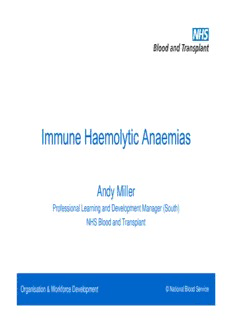
Immune haemolytic anaemias: Andy Miller - UK Blood Transfusion PDF
Preview Immune haemolytic anaemias: Andy Miller - UK Blood Transfusion
Andy Miller Professional Learning and Development Manager (South) NHS Blood and Transplant Organisation & Workforce Development © National Blood Service Haemolysis A reduction of the average circulating red cell life- span (120 days +/- 10 days) DAT Direct antiglobulin test Shows the presence of antibodies on the surface of the red cells (nothing more!) Organisation & Workforce Development © National Blood Service Maternal antibody coating foetal red blood cells ? Recipient antibody coating transfused red blood cells ? Patient's antibody coating autologous red blood cells ? Donor antibody coating patient's red blood cells ? Organisation & Workforce Development © National Blood Service Maternal antibody coating foetal red blood cells Haemolytic Disease of the Newborn - HDN Recipient antibody coating transfused red blood cells Haemolytic transfusion reaction - HTR Patient's antibody coating autologous red blood cells Autoimmune haemolytic anaemias - AIHA Donor antibody coating patient's red blood cells Haemolytic transfusion reaction - HTR Organisation & Workforce Development © National Blood Service Non-serological Serological Hereditary AIHA spherocytosis Warm-type elliptocytosis Cold-type thalassaemias Paroxsysmal cold haemoglobinuria - PCH haemoglobinopathies Paroxsysmal nocturnal Rhnull disease haemoglobinuria - PNH Drug Induced Mechanical anaemias Combined warm/cold Microangiopathic Infectious agents HDN/HDF HTR Organisation & Workforce Development © National Blood Service Diseases Associated with AIHA Reticulo-endothelial neoplasms (CLL and lymphoma) Myelodysplastic syndromes Systemic lupus erythematosus Infection (especially post-viral in childhood) Immunological diseases Organisation & Workforce Development © National Blood Service Routine blood donors - positive DAT 1 in 2175 [NBS-Colindale 2000] 1 in 5400 [NBS-Birmingham 2002] Detected in crossmatch Why no destruction? Is the DAT really positive? Colloidal silica - autoclaved/storage in glass Rouleaux formation - high levels of immunoglobulis Wharton s jelly - collecting from cut cord Organisation & Workforce Development © National Blood Service Some treatments can cause positive DATs Anti-Lymphocyte Globulin (ALG) and Anti- Thymocyte Globulin (ATG) Anti-D and Immune Thrombocytopenia Purpura (ITP) Any immunoglobulin given can give rise to DAT positive and free auto / allo antibody Organisation & Workforce Development © National Blood Service Low affinity IgG auto-antibodies More likely with gels due to high shear forces Low levels of bound auto-antibody IgM and IgA auto-antibodies IgA auto-antibodies IgM auto-antibodies Organisation & Workforce Development © National Blood Service 5% AIHA 16% malignancy 19% surgery/bleeding 10% MDS Knight et al (2000) Organisation & Workforce Development © National Blood Service
Description: